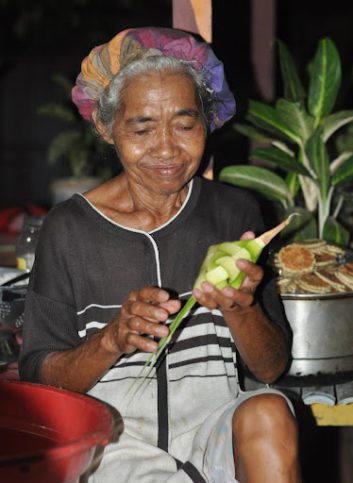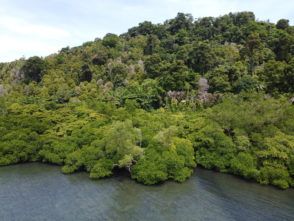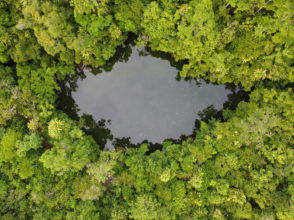This post is the first of a 3-part series on the use of customary law (sasi) by communities from Maluku archipelago in Indonesia and how these practices have helped communities to rebuild their fisheries.
My first experience of Sasi
September 2013 marked my visit to Maluku! I was excited as we flew from Jakarta to Ambon city in Maluku province – Indonesia. From above, I was amazed by the beautiful scenery with it’s blue and green landscapes. This is Maluku, an archipelago of Indonesia well known for its spices, pristine beaches and fascinating culture. My mission was to document the opening of a fishing closure in Haruku island whose management relies on a tradition known as sasi. Sasi is also a customary law that prohibits the extraction of certain natural resources for a given period in a bid to conserve the quality and to increase the abundance of natural resources.
Landing in Maluku, I boarded a small fiberglass boat at Tulehu Port in Ambon Island for a 30 minute trip to Haruku Island, reporting first to the home of Eliza Kissya “Om Eli” – the head of the kewang (natural protector/ranger) in Haruku Island where I stated the reasons for my visit. The warm welcome given to me by Om Eli’s family and his wife Elizabeth “Oma Liz” was testament to the culture that has made Sasi successful.

Oma Liz is busy preparing delicious food for the sasi opening. Photo credit: Indah Rufiati
Haruku Island is part of a cluster of islands – gugus Pulau-pulau that consist of Saparua Island and Nusa Laut Island. In addition to Ambon Island, these are known as the Pulau-pulau Ambon dan Lease or “Ambon and Lease islands”. They are located at the south of Seram Island – Maluku archipelago’s second biggest island and are well known for applying sasi. Sasi’s main aim is to control the relationship between man and nature.
By observing ‘sasi’, we increase efforts to preserve social norms that also focus on equal utilisation of natural resources by all members of the community” – Eliza Kissya, Head of the Kewang, Haruku village – Maluku, Indonesia
To ensure the success of sasi, a customary board known as the Dewan Adat Saniri defines roles through meetings and assigns these roles to the Lembaga Kewang, a natural protector and ranger body to oversee the implementation of the sasi. Lembaga Kewang comprises the head of sea protection – Kewang Laut, the head of land protection – Kewang Darat, secretary, treasurer and members. The members of Lembaga Kewang are chosen from each Soa (clan) in the village. While the heads of Lembaga Kewang for both sea and land are appointed based on their bloodline.
The sasi unit

Eliza Kissya (center) and kewang members preparing a traditional ceremony for the sasi opening. Photo credit: Indah Rufiati
As the person in charge of overseeing the implementation of sasi, Eliza Kissya has the right to sanction those who break the sasi rules. He also defines and leads patrols of sasi forests, rivers and sea areas, as well as chair meetings related to sasi. Appointed as the head of the Kewang in 1976, Eliza has dedicated his life to protecting the environment around Haruku Village. He is a prominent conservationist, artist and poet who also wrote a book about sasi in Haruku Island as part of the efforts to preserve the cultural heritage of sasi. Between 2007 – 2012, he was also appointed as a member to the national board of AMAN (Aliansi Masyarakat Adat Nusantara/National Indigenous Community Alliance).
Sasi in practice
In Haruku Island, there are four kinds of sasi: sasi for the sea, river, forest and homeland that have been implemented by the communities for centuries with some additional rules adapted to the modern world. Some of these adaptations include switching off the engine in rivers, and prohibiting the use of high impact fishing gear like nets that can catch all sizes of fish, including juveniles. Additionally, offenders pay fines in the form of cash. Sasi has also led to the inclusion of women who were not allowed to climb trees but the availability of appropriate clothing like long trousers has provided women with an option to climb trees to pick fruits. These adaptations of sasi to a changing society means that it is not rigid but dynamic with the times.

The sign that sasi is being implemented. Photo credit: Indah Rufiati
One of the interesting developments under sasi contributing to conservation is sasi ikan lompa (temporary closure for lompa fish – Thrissina baelama). Under this sasi, the communities close to the fishing grounds stop fishing to give fish time to grow. The presence of juveniles signals the start of sasi ikan lompa. A sign made from wood and young coconut leaves is put up by the head of the Kewang during a traditional ceremony to signal the start. The period of the closure lasts around five to seven months – allowing the fish to get bigger. At the start of the closure, the Lembaga Kewang holds weekly meetings each Friday to discuss the time for closure reopening. After deciding on the reopening time, findings are reported to the head of the customary village – Raja Negeri) who then announces the reopening time to the whole village.
On the reopening day, a traditional ceremony led by the head of the Kewang includes the burning of coconut leaves called lobe at 3 AM – symbolising a call for the fish to enter the estuary. Around this time, lompa fish, living both in the sea and the river estuary usually enter the river to breed. As the fish swim into the river, the community sets traps to catch the adult fish. The fish caught during the reopening is solely for protein reserves that are useful to the community during bad weather and low fishing season. The catch is also allocated to old people, widows, widowers and orphans. The community usually processes the fish through drying after landing it. The end of the reopening day is marked by a community party known as makan patita or ‘eating together’ where each household brings food to share with each other – a practice that leads to increased unity.
From witnessing the sasi process, it is evident that culture and indigenous knowledge can play a big role in communities contribution to conservation. I am grateful to have been able to spend two weeks on the island, in the home of Eliza Kissya and family, and witnessing this amazing custom to conserve natural resources, watching beautiful traditional ceremonies, and eating delicious food cooked by Oma Liz. Eliza Kissya, his family and the community of Haruku Village have inspired me to dedicate my career to conservation since then.
Look out for part 2 – sasi and co-management
I would like to acknowledge Eliza Kissya, Elizabeth Kissya and family for hosting me, the entire community of the Haruku village for their warm welcome and sharing of their experiences with sasi and to Muhammad Ridwan Alimuddin, Anwar Jimpe Rachman and Jerian Sitanala for their support.






